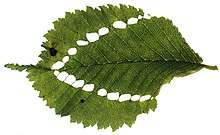Epinotia abbreviana
Epinotia abbreviana is a moth of the family Tortricidae. It is found in Europe and was first described by Johan Christian Fabricius in 1794.[1]
| Epinotia abbreviana | |
|---|---|
.jpg) | |
| Scientific classification | |
| Kingdom: | Animalia |
| Phylum: | Arthropoda |
| Class: | Insecta |
| Order: | Lepidoptera |
| Family: | Tortricidae |
| Genus: | Epinotia |
| Species: | E. abbreviana |
| Binomial name | |
| Epinotia abbreviana | |
| Synonyms | |
| |
Life cycle
The moth can be found in June and July flying at dusk and night. During the day it can be found on the trunks or foliage of elm (Ulmus species). It occasionally comes to light.[2]
Larvae

Larvae can be found from April to June, with early instars initially feeding within a developing bud, perforating the leaf. As the bud opens, the leaf expands to show the distinctive feeding pattern. Later they feed in a spinning on another leaf. Field maple (Acer campestre) is also eaten and larvae have been found on greater stitchwort (Stellaria holostea), which indicates it will eat herbaceous plants if dislodged from its normal feeding place on elm.[3]
Distribution
This moth is found all over Europe from Ireland to Russia.[1]
References
- "Epinotia abbreviana (Fabricius, 1794)". Fauna Europaea. Retrieved 10 October 2019.
- Kimber, Ian. "49.234 BF1150 Epinotia abbreviana (Fabricius, 1794)". UKmoths. Retrieved 10 October 2019.
- Bradley, J D; Tremewan, W G; Smith, Arthur (1979). British Tortricoid Moths. Tortricidae: Olethreutinae. London: Ray Society. pp. 125–6. ISBN 0 903874 06 7.